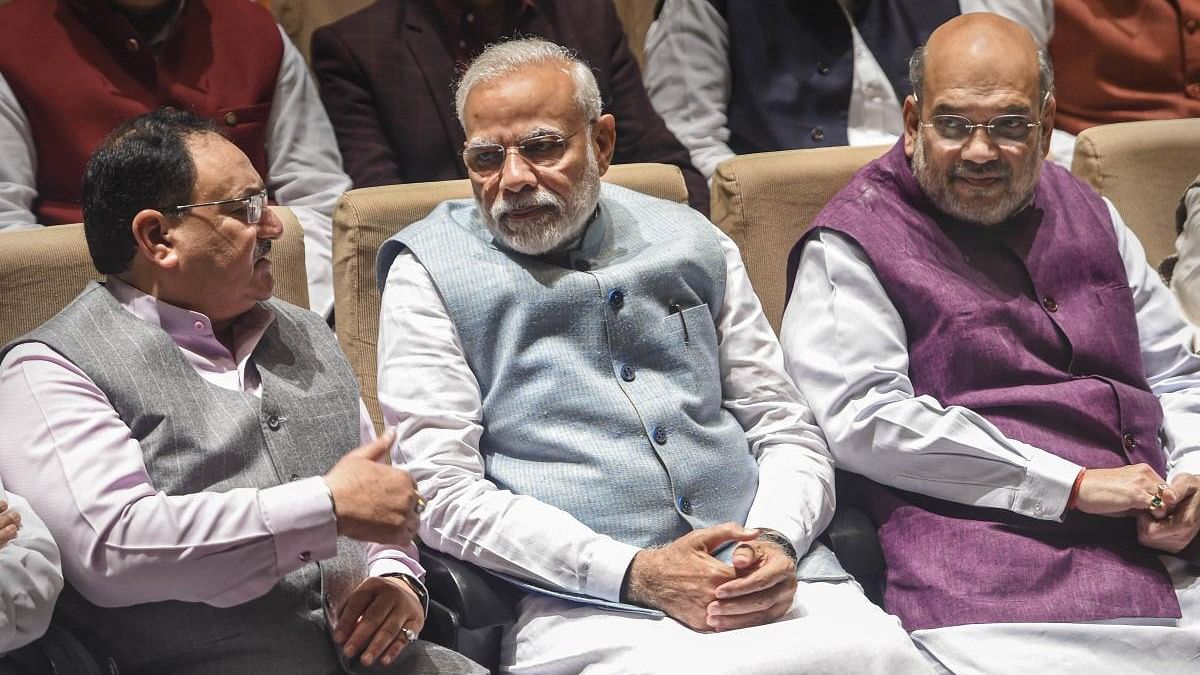
BJP top leaders J P Nadda, Narendra Modi, and Amit Shah seen here (L-R)
Credit: PTI Photo
Nearly three months after it won two of the five Lok Sabha seats in Jammu and Kashmir, the Bharatiya Janata Party (BJP) is trying hard to repeat its 2014 performance in the upcoming Assembly elections.
The saffron party had then won 25 out of the 87 seats, and in March 2015 formed a coalition government led by the J&K People's Democratic Party (PDP).
Three years later, in July 2018, the BJP snapped ties with the PDP after which Jammu and Kashmir came first under governor's rule and then under president's rule till 2019 when the Narendra Modi-led government abrogated Article 370 that accorded special status to the state. It also downgraded and divided the state into two union territories — Jammu and Kashmir, and Ladakh.
Since 2019, the erstwhile state has been under the Centre’s rule with the lieutenant governor (LG) running the show. The Assembly elections are now being held as per the directions of the Supreme Court which had set the deadline of September 2024 for the polls.
Challenge for BJP
The BJP won the Jammu and Udhampur Lok Sabha seats. Its move to not contest from the three Lok Sabha seats in Kashmir was then considered as an acknowledgement of a non-existent party organisation, and also the ground realities there.
This time, however, the party has decided to field its candidates from the Valley too. Perhaps, there is a realisation within the BJP leadership that it should not completely abandon its space in Kashmir despite not having much hope from there. For it, the stakes are higher in the Jammu region. The challenging task for the party would be to retain its 2014 tally of 25 seats.
Why is it challenging for the BJP? The sentiment that prevailed in the Lok Sabha elections earlier this year no longer resonates on the ground. The Assembly elections are more about local issues and candidates rather than the ‘Modi factor’ or the Hindutva agenda that got a major boost after the consecration ceremony of the Ram temple at Ayodhya in January.
The BJP successfully encashed those in the Lok Sabha polls. But party leaders privately admit that Jammu appears to be a tough terrain this time as the locals feel the pinch of economic hardships triggered by several factors. The Union government's move to scrap the 149-year-old practice of Darbar Move, a bi-annual practice of shifting the seat of governance between the capitals of Srinagar in summers and Jammu during winters, in July 2021 had hit hard the local business community. It was then argued that the government would save the exchequer Rs 200 crore annually by shelving the practice. However, traders from Jammu claim that the move has caused a loss of Rs 500 crore to both small and big businesses as 'Darbar Move' employees and their family members (read Kashmiris) would shop in Jammu during the six winter months.
Also, there is now a direct train service to Katra, the base camp for the pilgrimage to Mata Vaishno Devi Temple, which means that pilgrims no longer stop and shop at Jammu before visiting the holy shrine. These traders have further claimed that their financial woes are going to multiply with the launch of the train service to the Kashmir Valley.
These are going to be major talking points during the campaign for the upcoming elections, and whichever party promises to address these issues stands to gain. The BJP is visibly on a backfoot here given that it has been in power at the Centre since 2014 and ruling the union territory post-2019 through the LG.
Trouble Within
Apart from that, the BJP is also facing internal dissension. The growing dissent could be gauged by the fact that the party had to withdraw its first list of 44 candidates within minutes of its release on August 26.
The official line given to the media was that the list comprising the names of party candidates on 44 out of the total 90 seats (the number increased by three seats from 87 after the delimitation exercise in 2022 that earmarked 43 seats to the Hindu-majority Jammu region and 47 to Muslim-majority Kashmir) was inadvertently released. But the damage had been done.
The move triggered widespread speculation that there was a backlash over the omission of certain names in the list. The party later re-released its list of 15 candidates for the first phase of elections on September 18. The second phase will be held on September 25, and the final phase on October 1, while the results will be out on October 4.
After the initial faux pas, the BJP has declared 45 candidates. While former deputy chief minister Nirmal Singh has been dropped, the names of Jammu and Kashmir BJP president Ravinder Raina, former deputy chief minister Kavinder Gupta and ex-ministers Bali Ram Bhagat, Sukhnandan Choudhary, and Sham Lal Choudhary have not been announced yet.
The BJP is also grappling with an 'insiders versus outsiders' fight as loyalists have raised a banner of revolt against the party for giving prominence to turncoats in ticket distribution. The BJP leadership is desperately trying to douse the fire and set its house to get battle-ready. That said, a dip in its 2014 tally from Jammu will deal a big blow to the BJP.
A surge in terror activities, especially in the Jammu region, might polarise the elections, increasing the aggressive rhetoric, and thus overtaking the development issues.
(Aurangzeb Naqshbandi is a senior journalist who has been covering the Congress for 15 years, and is currently associated with Pixstory. Author’s X handle: @naqshzeb)
Disclaimer: The views expressed above are the author's own. They do not necessarily reflect the views of DH.